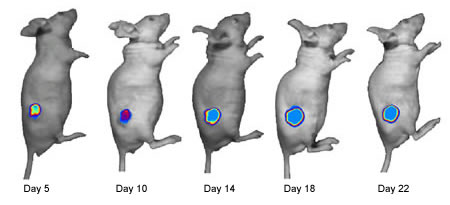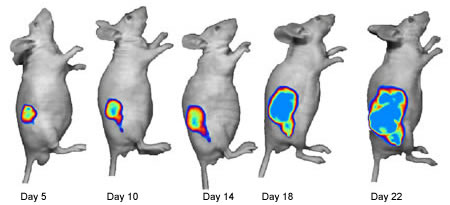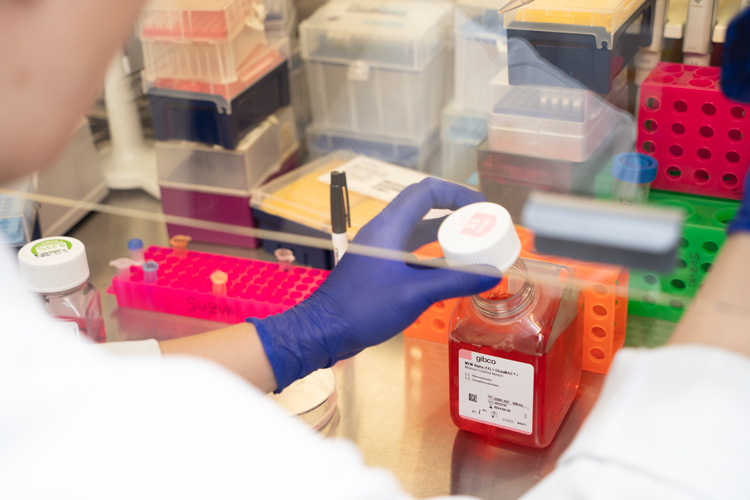RGI has recently transfected a number of human cancer cell lines with genes encoding the protein firefly luciferase (luc), green fluorescent protein (GFP) and red fluorescent protein (RFP). The transfected cells have been used in studies on anticancer agents as well as mechanisms of drug resistance. These cells can be implanted in athymic nude mice and monitored over time. Routes of administration can be 1) subcutaneous, which yields a tumor that grows similar to a primary tumor in a patient, 2) intraperitoneal, which yields cancer growth similar to ascites in patients and 3) intravenous, which yields tumors growing throughout the body, closely mimicking metastatic disease in human patients. By tracking the development or regression of these various cancer types, the effects of a particular treatment regimen can be accurately assessed.
RGI has developed and patented a unique model of metastatic breast cancer. The GI-101 human tumor xenograft is the only xenograft, breast or otherwise, that spontaneously metastasizes to clinically relevant sites from a subcutaneous implant 100% of the time. As such, the GI-101 model is one of the best models available for studying breast cancer and the metastatic process. It can serve as a model for scientists performing basic and applied research into many different areas including metastasis, dormancy and oncogenesis. It can further serve as a means to evaluate anti-cancer and anti-metastatic therapeutic regimens.
Imaging of cancer cells in the murine body has allowed us to visualize the location of tumors resistant to anti-cancer drugs. As a result of visualization, we are now able to remove resistant tumors and determine what has made them resistant. Our ability to determine not only the presence of disease but also the exact location of resistant tumors enables us to harvest these tumors and perform various analyses on them. We are able to dissociate the tumors and study them in culture with other anti-cancer drugs or evaluate them for genetic alterations that have rendered them resistant.
RGI is currently evaluating new methods for performing in vitro analyses of anti-cancer agents. Our goal with this research is to develop a more accurate, reliable tool for performing quick and inexpensive analysis of the effects of anti-cancer agents.
We are currently utilizing rotating wall vessels, developed by NASA, to grow 3-dimensional tumors in vitro. This technology allows us to culture human cancer cells in very low gravity. The resulting tumors are structurally very similar to tumors grown in vivo and in patients. These three dimensional tumors (tumorettes) behave much more like real patient tumors than any other cells cultured in vitro. The “tumorettes” are more drug resistant than their 2-D counterparts and form structures that are morphologically similar to patient tumors. We are working in collaboration with scientists from NASA on this exciting project.
The following images are taken from a poster that was presented at the Society for Molecular Imaging annual meeting in 2003. The human breast cancer cell line, MCF-7, was transfected with the luciferase gene and implanted intraperitoneally in nude mice. The mice were then treated with the chemotherapeutic agent, topotecan. As you can see, topotecan inhibited the development of disease while the untreated animals developed large tumors. The ability to monitor tumor development over time gives scientists the opportunity to study many different facets of cancer biology including drug resistance mechanisms, drug efficacy on metastatic tumors, tumor development in various body sites and many others.
These images are of the human prostate cancer cell line DU-145 that was implanted
subcutaneously in nude mice. The cisplatin treated group demonstrated very little
tumor growth compared to the untreated controls. Tumor volume was also measured with
calipers and the two methods correlated very well.
DU-145 Luc Cisplatin Treated

DU-145 Luc PBS Control

These images are of the human breast cancer cell line LN-1 grown in rotating wall vessels. Note the three-dimensional structure that closely resembles tumors grown in vivo.


